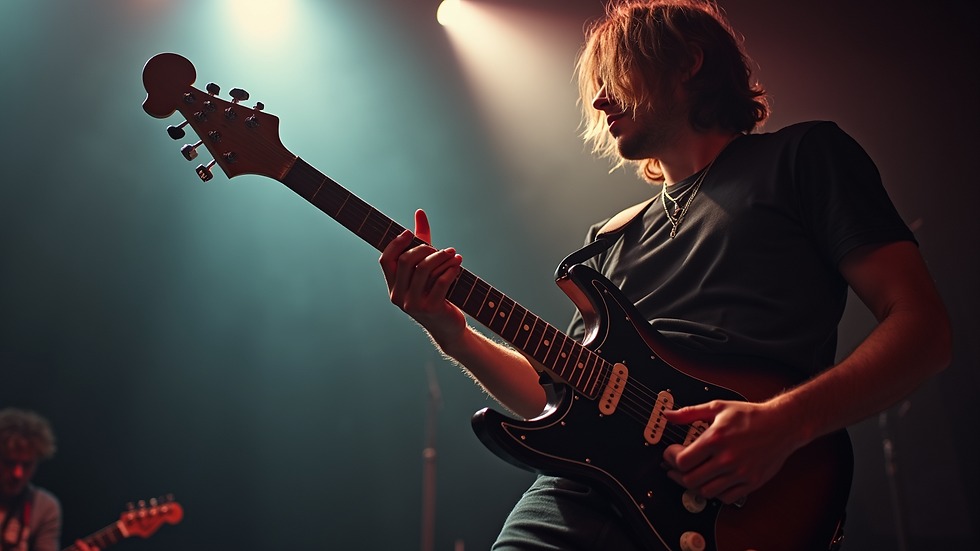Concert Moments: Music Photography Techniques
- kingdomofem
- Jul 29
- 4 min read
Capturing the energy of a live concert is a thrilling challenge for any photographer. The lights, the crowd, and the performers create a unique atmosphere that is both exciting and unpredictable. Whether you are a seasoned pro or just starting out, understanding the techniques of music photography can help you take stunning images that tell a story.
In this post, we will explore various techniques to enhance your concert photography. From understanding lighting to mastering composition, these tips will help you capture those unforgettable moments on stage.
Understanding Lighting
Lighting is one of the most critical aspects of concert photography. Concerts often feature dramatic lighting that can change rapidly. Here are some tips to help you navigate this challenge:
Use a Fast Lens: A lens with a wide aperture (like f/2.8 or lower) allows more light to enter the camera. This is essential in low-light situations typical of concerts.
Adjust Your ISO: Increasing your ISO can help you capture images in darker environments. However, be cautious, as higher ISO settings can introduce noise. Experiment to find the right balance.
Watch for Color Changes: Concert lights often shift colors. Be prepared to adjust your white balance settings to maintain accurate colors in your photos.
By understanding how to work with lighting, you can create images that truly reflect the concert's atmosphere.
Composition Techniques
Composition is key to creating engaging concert photos. Here are some techniques to consider:
Rule of Thirds: Imagine dividing your frame into a grid of nine equal parts. Place your subject along these lines or at their intersections for a more dynamic composition.
Fill the Frame: Get close to your subject. This can help convey emotion and energy. A close-up of a guitarist's hands or a singer's expression can tell a powerful story.
Capture the Crowd: Don’t forget about the audience. Including fans in your shots can add context and show the connection between the performers and their audience.
Experimenting with these composition techniques can elevate your concert photography.
Timing is Everything
In concert photography, timing is crucial. Here are some tips to help you capture the perfect moment:
Anticipate Key Moments: Watch for moments like a singer hitting a high note or a drummer striking a powerful beat. These moments often create the most impactful images.
Use Burst Mode: Many cameras have a burst mode that allows you to take several shots in quick succession. This can be helpful for capturing fast-moving performers.
Be Patient: Sometimes, the best shots come from waiting for the right moment. Stay alert and ready to capture the unexpected.
By mastering your timing, you can capture the essence of the performance.
Equipment Essentials
Having the right equipment can make a significant difference in your concert photography. Here are some essentials to consider:
Camera Body: A DSLR or mirrorless camera is ideal for concert photography. These cameras typically perform better in low light and offer more control over settings.
Lenses: A fast prime lens (like a 50mm or 85mm) is great for portraits, while a zoom lens (like a 24-70mm) offers versatility for different shots.
Memory Cards: Concerts can be fast-paced, so having extra memory cards on hand is essential. You don’t want to miss a moment because your card is full.
Investing in the right equipment can help you capture stunning concert images.
Post-Processing Tips
Editing your photos can enhance their quality and bring your vision to life. Here are some post-processing tips:
Adjust Exposure: Sometimes, concert photos can be underexposed or overexposed. Use editing software to adjust the exposure and bring out details.
Enhance Colors: Concert lighting can create unique color casts. Use color correction tools to adjust the hues and make your images pop.
Crop for Impact: Don’t be afraid to crop your images to improve composition. A tighter crop can help focus on the subject and eliminate distractions.
Post-processing is an essential step in creating polished concert images.
Capturing Emotion
One of the most powerful aspects of concert photography is capturing emotion. Here are some ways to do this:
Focus on Expressions: Look for moments when performers express joy, passion, or intensity. These moments can create a strong connection with viewers.
Show Interaction: Capture moments of interaction between band members or with the audience. These shots can convey the energy of the performance.
Use Depth of Field: A shallow depth of field can help isolate your subject and draw attention to their emotions. This technique can create a more intimate feel in your images.
By focusing on emotion, you can create images that resonate with viewers.
The Importance of Practice
Like any skill, concert photography improves with practice. Here are some ways to gain experience:
Attend Local Shows: Start by photographing smaller, local concerts. This can help you build your skills without the pressure of larger events.
Experiment with Different Genres: Different music genres can offer unique challenges and opportunities. Try photographing rock, jazz, or electronic shows to diversify your portfolio.
Seek Feedback: Share your work with other photographers or online communities. Constructive feedback can help you identify areas for improvement.
The more you practice, the better your concert photography will become.
Final Thoughts
Capturing concert moments is an exhilarating experience. With the right techniques, equipment, and practice, you can create stunning images that tell a story. Remember to embrace the energy of the performance and let your creativity shine.
As you embark on your concert photography journey, keep these tips in mind. Each concert is a unique opportunity to capture unforgettable moments. So grab your camera, head to a show, and start creating memories through your lens.



Comments